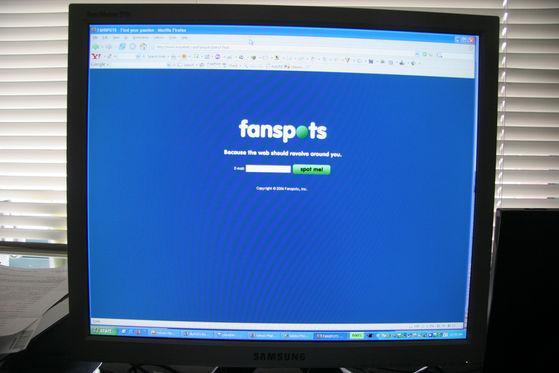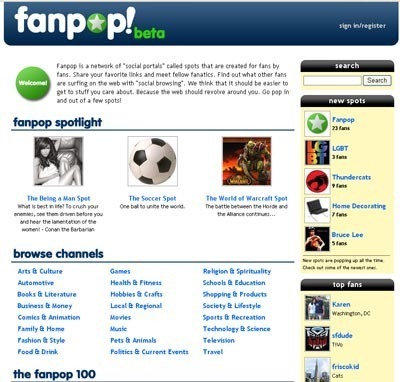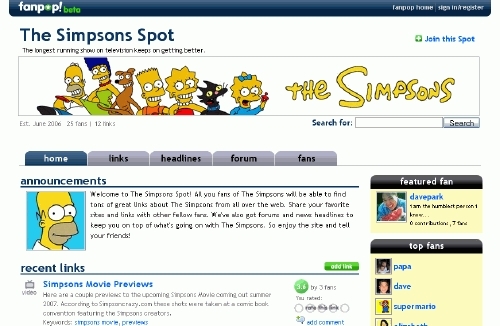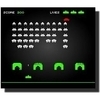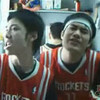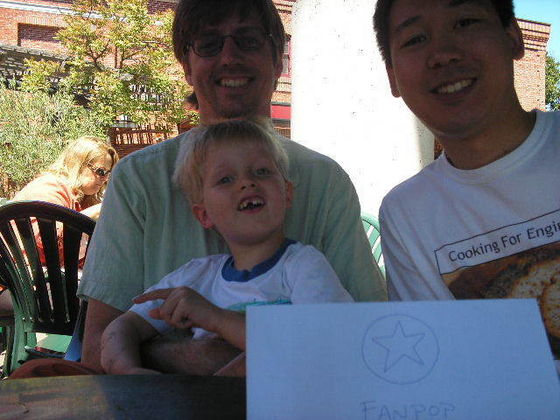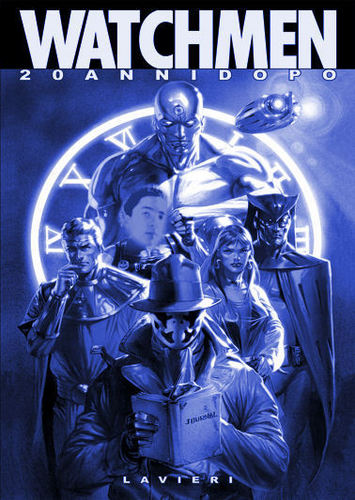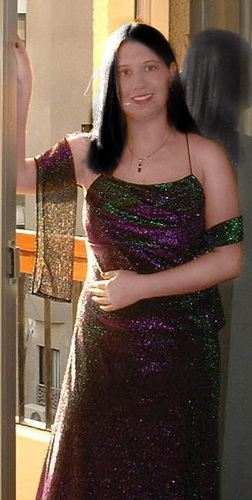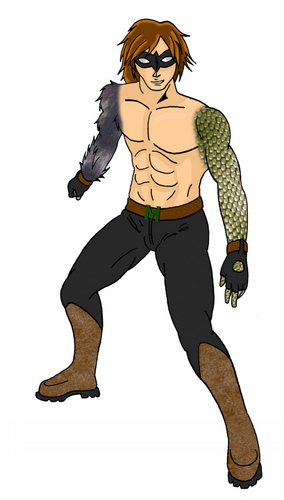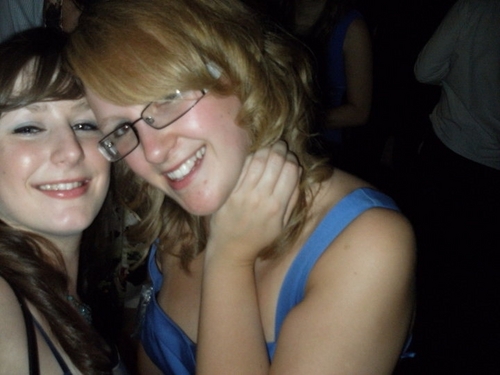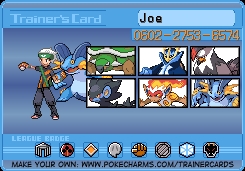This 記事 was started back in December, and was last edited here on 8 June 2008.
2006 was a tumultuous 年 for me. In the spring my wife and I discovered that we were pregnant again, and believe me when I say that there are a host of attendant anxieties that come with any pregnancy. How could we fit another person into our already-cramped house? How could we afford to support another? Beyond that, I'd just become the project manager of a pretty high-profile project in the middle of the project, and that had a bunch of issues that I inherited.
In the midst of this, I was invited to participate in a beta test of a new web site, called Fanspots. However, since I work on web sites for a living, I didn't check out the site right away. I put it off because I like to be thorough in my testing, and I knew that to test a new site would take a fair amount of my time. I couldn't have imagined what the truth of that was to be!
Eventually, I did finally follow the link and register for Fanspots. What I found was a nice, user-friendly site where one could collaborate with others to catalog everything that was outstanding about a particular subject online. I threw myself into testing, bombarding the staff with multiple e-mail messages each 日 - a lot of bug reports and the occasional request.
Let me explain about the typical test cycle. (note: this paragraph is esoteric to testing, and your eyes may glaze over) With a product - whether it be a video game, tax prepartion software, a web site, または any other kind of software - the team that builds the product will "spec out" (that is, describe everything in a detailed specification document) the desired details of the product, then デザイン the product, and then conduct some internal testing of the product once the デザイン is finished. This first round of tests, internal to the company that built the product, is commonly referred to as alpha testing. During the "alpha", the designers will gather data on what isn't working as expected and afterward use them as the focus of the 次 round of development - often called bug fixing even though sometimes there are problems with the product's features themselves, and not just software bugs. After those "fixes" have been addressed, the team will often (if they're wise) open up the product to a larger yet finite group of testers outside of the company for a "beta test". In a proper beta test, this significantly large but finite group of testers is encouraged to try to break the site - not necessarily through malicious behavior, but によって trying every possible combination of normal user actions. Also, the very fact that they're doing such thorough testing will also be testing the load capacity of the site (bandwidth, load times, session limits, et cetera) in a way that the product team, being much smaller, could not. A lot of such testing involves clicking on a link and observing what happens, first as a public (that is, not logged on) user, then again having logged on, then again having just logged off...you get the idea. Further, あなた do this on as many different web browsers as あなた have readily available. あなた take careful notes as to what combination of tests you're doing, so that when something goes wrong - または just behaves unexpectedly - あなた can レポート useful information. See, it's no good to say "This link doesn't work" - that doesn't actually provide any worthwhile info. It's better to say something like "At 5:13 PT, I was using Opera 7.1 when I clicked on this link, <link name> on this page: <URL>. Instead of taking me to the expected page, I ended up on the Fanspots main page."
(just an aside on web geekdom: a web geek will always refer to the page that appears when あなた enter the base URL - for example, link - as the "main page" or, most correctly, the "top page", never the "home page". A ホーム page is the page a user sets in the preferences of his/her browser, which appears whenever that person clicks the "home" button on his browser)
So, I was doing a lot of testing. A significant part of the site involved adding content, however, and so I started posting リンク and creating spots. Now, back in its infancy, Fanspots was very different than the ファンポップ あなた enjoy today, and in もっと見る ways than just the name.
The main page
The spots were organized into different channels, and much もっと見る attention was 与えられた to the channels then than there is today. For one thing, the 一覧 of channels was one of the first things you'd see on the main page!
The site was organized into columns back then, much as it is today, but back then, the right column was about 1/5 of the page width, so much narrower. The first thing あなた saw in the right column was a ランダム 一覧 of five new spots that had been promoted from pending. Below that was a 一覧 of "top fans" - which I believe was a ランダム listing of users who had プロフィール pictures and had been active on the site recently. Each "top fan" was listed with one spot (if I recall correctly, it was the spot to which they'd most recently contributed). Below that was a ランダム listing of pending spots.
Back then the site seemed much もっと見る organized around the idea that people would come to Fanspots knowing the topic または topics they wanted to find, and then look for it によって category, much as あなた would look something up in a reference book または library.
Spots themselves
Inside a spot, there were only links, the forum, and headlines. A spot had a logo and a banner, just as today, but the logo appeared under the banner, in a section right at the 上, ページのトップへ entitled "announcements", which was basically a place to provide a detailed 説明 of the spot and/or provide アップデート to the ファン of that spot. Each spot, when created, had some filler copy inserted into this announcements area which could then be changed. によって default, it read like this (sic):
"Welcome to the <spot name> spot! All あなた ファン of the <spot name> will be able to find tons of great リンク about the <spot name> from all over the web. Share your お気に入り sites and リンク with other fellow fans. We've also got フォーラム and news headlines to keep あなた on 上, ページのトップへ of what's going on with the <spot name>. So enjoy the site and tell your friends!"
Other differences on the main page of each spot: the 月 and 年 the spot was created was displayed just under the banner. To the right of the announcements was a place where a ランダム ファン of that spot was featured, with a larger version of the fan's プロフィール picture, the fan's motto, and a tally of the fan's total contributions and fans. Under that in the right column was a ranking of "top fans" for that spot, while under the "announcements" section - the main body of the page - was a 一覧 of the most 最近 links. Down below the fold (more geek-speak: the "fold" is the bottom edge of what あなた can read on a web page without scrolling または paging down - those of あなた who've worked in print media may recognize it as a quaint reference to newspaper publishing - the fold is important in web publishing because anything below the fold is several times less likely to be seen によって the average user) was a section 表示中 a few headlines as well as a section 表示中 フォーラ updates. あなた may not believe it now, but back then, the fora were practically unused in almost all spots!
Each spot feature had its own tab, of course - and yes, they were big honkin' tabs rather than the simple リンク under the banner that they are today - where あなた could go and see all the headlines, for instance, または all the フォーラ threads.
On Fanspots, when あなた created a spot, あなた had the power to 編集 the banner, logo and announcements of any spot indefinitely. When あなた added a link to a spot, あなた provided a name, an URL, a description, keywords, a rating, and a category. See, all content in a spot was classified as links, but あなた had to specify a category of link. リンク could be classified as one of the following: web sites, blogs, photos, games, videos, recipes, reviews, articles...Ah, I'm sure I'm missing a few, since I seem to recall there were something like twelve categories.
Early Addiction
Working as assiduously on testing as I was, I couldn't tell あなた when I crossed over from being a tester to being a full-fledged user and ファン of the site, but it had happened over the course of a few weeks, as the number of bugs I could find decreased and the number of spots that had been created increased. The two most 人気 spots back then were link and link - they consistently had ten times the number of ファン of any other spot. Shortly after this was the time that I created the link, which may be the first spot I created where I was hooked on adding content continuously. At the same time, I was hooked on the idea of making Fanspots as comprehensive a site as possible によって filling in spots with all of my interests. Back then, I was creating several spots a day, and after a while I had to create rules for myself so that I would take care of other stuff in my life. At first I 発言しました that I would add only ten リンク to Fanspots a day. Then I added that I would create only one spot a day, and I was mostly able to keep it down to that most of the time.
But I have to say that today it is still something of a surprise to realize that Viral 動画 isn't even in the 上, ページのトップへ 40 spots in terms of fans...
Early Retirement
Shortly after I really got started, early in July, the Fanspots staff started ramping up to go public with the URL fanspots.com, which meant that, in theory at least, there would quickly be a much larger and もっと見る diverse body of users to test the site. As part of this push, the staff created a Flickr account and a link. Sometime in the latter half of July 2006 though, as they prepared to make the fanspots.com domain publicly accessible as an URL, the Fanspots staff discovered that a different company had just registered and launched fanspot.com, a social network for team-sports fans. So they link from one 日 to the next. All the branding, logos, text, リンク - everything had been changed to "Fanpop"!
あなた gotta hand it to the guys - they work fast!
If あなた go back through my early フォーラ posts, you'll likely read my whining about the name change. I really liked Fanspots and really didn't care for ファンポップ as a name at first. In fact, as I recall, it took me at least as long to be reconciled to the name ファンポップ as I'd even used the site with the name Fanspots!
As further part of the prep for the launch, there were some changes to the 上, ページのトップへ page beyond just the name change: the ファンポップ 100 was created. The ファンポップ 100 was a 一覧 of the most 人気 リンク on the site (determined, I thought, on a combination of ratings and views, similar to what I think determines the "What's Hot" ranking in each spot today). The ten most 人気 were listed on the 上, ページのトップへ page, but あなた could click a link to see the rest of them. As あなた might imagine, having this 一覧 on the 上, ページのトップへ page became sort of self-perpetuating (not that the content didn't deserve to be there, but after a while it was tiresome to see the same リンク 日 in, 日 out): being on the 上, ページのトップへ page made it WAY もっと見る likely that someone would look at it. It seemed like link was in the 上, ページのトップへ 10 for over a month, for example. A new section was added to the right column: "Recent Updates", which showed a 一覧 of the spots to which content had been added most recently.
Beta launch
The URL www.fanpop.com went public on 1 August 2006 and slowly but steadily people began discovering the site and using it, in part from the large amount of blog coverage the site received with its launch.
link was created either right before または right after the launch (I think it was right after) as a place to share information about the web site, with a bunch of リンク to press releases and blog postings about Fanpop.
Within a 月 of launching, the staff created a number of new features to promote increased registration for the site: invite a friend, link sharing, and the ファンポップ bookmarklet. There was a general feeling that the important thing for the site's success was to get as many registered users as possible, and so we users threw ourselves into that task.
Over the life of the feature, the "invite a friend" has changed multiple times. In every incarnation, it is essentially a way for the user to enter e-mail addresses of フレンズ または family so that an invitation to register for ファンポップ would be sent to them. In an early incarnation of the feature, one was allowed to write a personalized message to the recipient, which was then appended to a boilerplate message about Fanpop. Real-world experience (as reported によって the staff) shows that this isn't the best way to go, so the invite-a-friend and share a link features no longer let あなた personalize the message. Instead, it sends a very spam-seeming message "Someone is a ファン of you!" The reason is that our testing - that is, our using of the site - demonstrated that もっと見る people click on a spam message like that than actually click on a message from their friends. Go figure!
Ratings and cataloging content on the web
I mentioned before that an early concept for the purpose of the site was to collaboratively catalog all the worthwhile content on a subject available online. あなた know and I know that this serves a very important purpose, since the ability of 検索 catalogs to find relevant content on a particular subject is necessarily limited, so having a place where あなた really only have content related to the topic あなた want is priceless. But not all material related to a particular topic is equal, so ファンポップ has the ratings system, where each user can rate how good, poor または middling each item is, under the premise that, while each spot will have a lot of content for its topic, the outstanding content will rise to the 上, ページのトップへ によって virtue of higher aggregate ratings.
The scale has always been the same: 1 星, つ星 for garbage (not broken content, just really lousy stuff), 2 stars for blah content, 3 stars for content that is OK, 4 stars for great content, and 5 stars for incredible, awesome content. Each user could, with the submission of a link, also provide a rating. So back then there was no content with no ratings on the entire site. The difficulty was that almost everyone would rate every one of their own submissions at 5 stars...over the course of several months I didn't see anyone other than myself and the staff that rated their own リンク as anything less than a 5. That's not to say that it didn't happen, just that I didn't see it. In addition, over time users became less and less likely to rate other content as anything other than a 5 (and, rarely, a 1), as if the other gradations didn't exist. This of course negated the benefit of having ratings for content, since all content was 表示中 up as being equally AWESOME!!!!
Medals
Right around launch, メダル were introduced as a way of motivating users to provide good content...or at least content that was highly rated によって other fans. メダル were apparently awarded to ファン in a particular spot who'd 投稿されました a lot of highly-rated and -viewed content in a spot. Then, as now, there were three kinds of medals: dedicated fan, die-hard fan, and fanatic. link, one of the non-staff users who added the most content to the site back then, quickly earned all three.
At launch, there seemed to be two ideas for medals: that of bragging rights for the user, and also increasing rights in the spot in question. In the initial testing of the site, a number of us had gone through and created a host of spots, trying to cover as wide a range of potential interests as possible. But I believe the idea was to not keep the control in the hands of the spot creator - often there would be もっと見る rabid ファン of a topic than the one who happened to create the spot - but to reward quality contributions, in the person of recipients of die hard ファン and fanatic medals, with increasing administrative powers. It wasn't entirely clear from the よくある質問 what these powers were to be, but conjecture suggested such things as changing the spot logo and banner, as well as editing and/or deleting flagged links. My impression is that this latter idea was quickly abandoned for the extreme potential for abuse that it presented. I imagine that both the potential for "gaming" the system to artificially acquire メダル and the danger of petty and punitive action によって medal holders who could then effectively prevent others from getting メダル brought the staff to their senses. メダル remained, from then through today, solely as an indicator of posting a lot of content that is both rated and viewed によって other fans, without the God-like attendant powers. (note: there is still link, as some もっと見る minor rights may persist)
Soapboxes
Then, in November 2006, the staff created a revolution in the whole concept of the site, によって enabling the creation of original content, in the form of soapbox articles. Before then, original content was limited to コメント and フォーラ thread posts, neither of which are searchable and were not intended as content but rather discussion. Remember that the concept of the site was to catalog all the worthwhile content "out there" on the web. But with soapbox articles, the ファン could suddenly create new, original content right here on Fanpop!
That's not to say that soapbox 記事 back then were the same as they are today. No no no - at the feature's launch, one could include images, but there was a 上, ページのトップへ image and then a whole bunch of bottom images. 記事 authors today can see the remnant of this in the naming of the image fields: they're still called "top image" and "bottom image 1 - X". The difference is, back then they really were bottom 画像 - あなた couldn't put them any place else!
The other difficulty that happened with the soapbox 記事 at the launch of the feature was the confusion about what constituted a valid soapbox article. There were a lot of postings where the user had confused the 記事 with a フォーラ post, and a LOT of postings of material that had been copied directly from another site: usually news 記事 lifted directly from the AP wire.
Favorites
At around the same time, お気に入り were introduced, which allowed us users to save particular リンク that we really loved so that we could revisit them もっと見る easily. Before that, we had to bookmark our お気に入り リンク in the browser.
Profile images
At certain points in my history of my first two years, I feel compelled to call out certain users for doing something extraordinary または being the first to do something. I've already called out dan and dave. Now I'll call out another user. プロフィール pictures were available for users from the very beginning: that is, users had one picture they used as their アイコン to visually represent themselves on Fanpop. Right around クリスマス 2006, I was startled to see that one of the site's big users had changed her icon! It might not seem like a big deal now, but link was the first user to regularly change her プロフィール picture. I was so impressed! Such an obvious thing, and yet no one had done it until she did. It took me a while, but eventually I followed suit, settling into my current practice of a new picture every month. As other users started changing their icons, too, I started posting their older 画像 to the link spot to maintain some continuity for very visual people (like me) who might otherwise get confused when the user's image changed too much.
Reducing link types
As もっと見る time passed, the staff played with the number of link types users could select when submitting a link. Much like with ratings (2,3 and 4, anyway), they were supplying a large 一覧 of options that hardly anyone was using. With each revision, the 一覧 got shorter.
Videos
Sometime after that, the staff started to incorporate video-embedding APIs into the site code, which allowed video リンク for the video sharing sites they chose (YouTube, Google Video, Guba, dailymotion, a few others) to display both thumbnail vid キャップ 画像 of the 動画 in 質問 and also to play the 動画 in the browser on ファンポップ (using Flash) rather than having the user leave the site for someplace else. This was another huge change, since it required that the organization of spots be changed to accommodate 動画 as a separate kind of link. At that point, リンク with URLs that pointed to video sites (or at least the ones with embedding code on Fanpop) were moved into the "videos" section of each spot, while all other link タグ were ignored and the option to specify different types of new link content was removed. Suddenly, all リンク were either "videos" または "other links", and the site's spots looked much もっと見る like they do today. あなた can still see this change reflected in older spots: if あなた browse their リンク section, at a certain point あなた are likely to find a big jump in the number of リンク to 動画 on other sites (ones for which ファンポップ has not enabled embedded code).
While the majority of users were slow to pick up on the soapbox feature, the change in how 動画 were handled revolutionized the site. Not only did vid キャップ 画像 of embedded 動画 embellish the 上, ページのトップへ section of every spot that had them (and left big blank areas for spots that didn't), but now ファンポップ was 表示中 up on 検索 catalogs a lot more. If あなた read the コメント on picks like link, you'll see that many users discovered the site shortly after this change, while searching for 動画 online.
Some time after that, ファンポップ partnered with the video hosting company VideoEgg to enable users to アップロード 動画 directly onto ファンポップ (rather than linking to another site). The feature required that users download and install some proprietary software which would enable the user's computer to accurately communicate with the video アップロード widget on Fanpop. You'd create a video, then click the "add video" link. At that point, あなた were presented with an option to link to a video, または upload your own video. When あなた selected "upload your own", a special video アップロード widget would load on the page. あなた could then browse your computer to select your video, which would then take a while to load in a プレビュー window. Once it had finished loading, あなた could play the プレビュー of your video to see how it would look. Once あなた were satisfied, あなた could then actually アップロード the video, which took some もっと見る time (depending on the size of the video - I recall that the allowed length for 動画 was capped at five minutes). Once あなた did all that, あなた could enter your キーワード and 説明 normally. It was a great feature, but it took a long time to do and, sadly, not many users ever bothered to try uploading their 動画 to Fanpop. At some point in the early spring of 2008, the feature was disabled and soon all mention of it was gone from the site.
Picks
In early spring 2007, the staff launched the polling feature called "picks" with link. This new feature caused a huge spike in registered users, since あなた had to register in order to answer a question, as well as to create one. link quickly distinguished herself as a creator of many fine questions. She was not the only one, though: since it was launched, at least 59,410 picks have been created (by the time I post this, the number will probably 上, ページのトップへ sixty thousand). The pick feature hasn't changed very much since its inception, however. The only changes I've noticed have been to accommodate もっと見る picks for a particular 質問 - it used to restrict the creator of a 質問 to many fewer initial picks. Now many もっと見る are allowed for the edge cases where a 与えられた 質問 would have a LOT of potential 回答 ("What's your お気に入り ディズニー animated film?" for an hypothetical example).
Images
A short time later, ファンポップ added the image feature in May 2007. Suddenly, users were able to アップロード icons, 壁紙 images, art they'd created themselves, and general 写真 to galleries in each spot. Most of us played with the feature, but link, who'd joined the site less than a week before the feature was launched, quickly became known as the image queen, at times uploading thousands of 画像 in a single day.
Props
Then, in June 2007, ファンポップ introduced the リスペクト feature. Before then users had to praise others in コメント または via mail message; now we were able to 提出する our praise to a publicly visible board all in one place...and the site kept a tally of all リスペクト you'd received in each category!
Ratings
Sometime in summer 2007, two changes happened to the ファンポップ ratings system. First, a tally of ratings was added to our プロフィール pages, to 表示する how much content users had rated. My guess is that the staff wanted to encourage users to rate more, since at that point it was still common to browse the site for hours and not see any リンク that hadn't been rated によって もっと見る than one user. However, the tally included all ratings each user had made, even on their own content. There was a fair amount of boasting from users who'd 投稿されました tens of thousands of content links, and competition got ugly. Shortly thereafter, the staff removed the ability for an user to rate his own content, and it was as if it had never been. From one moment to the next, most users "lost" a giant number of ratings when their own ratings on their own content (which until then you'd been able to 提出する with the link itself, remember?) disappeared from their tallies. Myself, I went from 6,000 ratings to just over 2,000, which meant that I had added about twice as much content as I'd viewed and rated others' content. Many had bigger drops than that.
Since then, we've been restricted to rating only content 投稿されました によって other users. It's not a competition によって any means, but it should be noted that link has long been one of the users with the most ratings. Those who know me know well that I don't advocate mass ratings - I think giving too much credence to the number of ratings a person has made too easily leads to rote rating without actually evaluating the content - but from what I've seen, she is very consistent in reviewing content リンク and rating them, rather than just skimming through image galleries.
User lunches
At that point I'd been kicking the idea around in my head for a while, but the 日 after the ファンポップ public beta launch anniversary - that is, 2 August 2007 - I started inviting anyone and everyone on ファンポップ who could do so to meet with others in their area for a regular link. I myself would announce a spot in the SF ベイ, 湾 Area I would be for lunch each 月 as an open invitation. I kept it up for six months, but the only person to 登録する me was link. I never heard if anyone in any other part of the world managed to get together for a social gathering. Maybe I'll try again in my area someday.
Merchandising
Anticipating the ファンポップ public beta launch anniversary (1 August 2007), a number of users (myself included) independently had the same idea and started agitating the staff to make ファンポップ merchandise available for purchase. It turns out that the online company they tried to use to make the stuff at first rejected their efforts as obvious copyright violations...not realizing that they were Fanpop and so owned their own copyrights! Eventually they got it sorted out, and the staff members brought their formidable デザイン skills to bear. Users first ordered stuff from the link in November 2007.
E-mail alerts
In November 2007, the staff launched the e-mail alerts feature, so that あなた could 編集 your プロフィール to enable e-mail notifications to be sent to your e-mail address. This has been invaluable for those of us who need a subset of our アップデート to be sent to us, so we're not lurking on the site 読み込み中 and reloading our update pages again and again. This way we can do other stuff online, secure in the knowledge that our e-mail 受信箱 will let us know the really important changes.
Profile galleries
In January 2008, the staff launched the link. Now those of us - and within a 年 of pirateroro doing it there were scores of others - who liked to change our プロフィール pictures could アップロード multiple pictures to keep in our own profile's gallery, rather than uploading the 画像 to the ファンポップ Users spot (or, later, the Users アイコン spot).
My Updates
No, not my アップデート specifically: the "my updates" feature. The top-level "My updates" collated listing on each user's プロフィール page was deactivated in May 2008. No user knows for sure, but I suspect that the staff has brought it down for performance reasons - so they can make it better, stronger, faster. Certainly they have the technology. While they figure out what to give us to replace it, we users have been viewing the specific listings of アップデート によって category: アップデート to our フォーラ threads, コメント on our links, content added to spots that we've joined, et cetera.
Pop Quiz
The pop クイズ feature was finally launched this month, June 2008. Now users can test their knowledge of their お気に入り topics, as well as challenge other users with the クイズ 質問 they add. The pop クイズ feature was tested for a few months before it was launched, and now ファン are also competing with the Super Quiz, composed of trivia all across the many spots on Fanpop.
A note in closing
So there we are: ファンポップ has changed a great deal over the last two years that I've known it. There's certainly stuff that happened that I didn't document here; these are just my recollections of a long period written over a long period. Astute readers will not be surprised to learn that I started thinking about this 記事 off-line around the time of the ファンポップ public beta anniversary (that means almost a year ago), and didn't actually start 書く a draft on ファンポップ until December. One thing led to another, and my "First 18 Months on Fanpop" turned into "My First 20 Months on Fanpop", then "My first 22 Months on Fanpop"...in the end I decided that I had to get it out at 2 years または I'd never get it done. So it's highly likely that I've missed stuff. If you're particularly aware of something I've missed, well によって all means write your own 記事 about it! You're almost certain to write faster and put out a もっと見る concise article, after all!
Two years and counting...
Two years now, and still going strong (both me and the site itself). It's been a great time for me. ファンポップ - as well as the wonderful users on the site that I've come to know - has been a delight as well as an obsession. But of course the staff isn't standing still; certainly もっと見る features are on the way, and the site is sure to experience significant changes in the coming year, too. What will they be? Will suggestion X from the link フォーラ thread get implemented? Will the site ever launch out of beta? Who can say?
The only thing I can say for sure is that whatever comes, it will definitely be good.
2006 was a tumultuous 年 for me. In the spring my wife and I discovered that we were pregnant again, and believe me when I say that there are a host of attendant anxieties that come with any pregnancy. How could we fit another person into our already-cramped house? How could we afford to support another? Beyond that, I'd just become the project manager of a pretty high-profile project in the middle of the project, and that had a bunch of issues that I inherited.
In the midst of this, I was invited to participate in a beta test of a new web site, called Fanspots. However, since I work on web sites for a living, I didn't check out the site right away. I put it off because I like to be thorough in my testing, and I knew that to test a new site would take a fair amount of my time. I couldn't have imagined what the truth of that was to be!
Eventually, I did finally follow the link and register for Fanspots. What I found was a nice, user-friendly site where one could collaborate with others to catalog everything that was outstanding about a particular subject online. I threw myself into testing, bombarding the staff with multiple e-mail messages each 日 - a lot of bug reports and the occasional request.
Let me explain about the typical test cycle. (note: this paragraph is esoteric to testing, and your eyes may glaze over) With a product - whether it be a video game, tax prepartion software, a web site, または any other kind of software - the team that builds the product will "spec out" (that is, describe everything in a detailed specification document) the desired details of the product, then デザイン the product, and then conduct some internal testing of the product once the デザイン is finished. This first round of tests, internal to the company that built the product, is commonly referred to as alpha testing. During the "alpha", the designers will gather data on what isn't working as expected and afterward use them as the focus of the 次 round of development - often called bug fixing even though sometimes there are problems with the product's features themselves, and not just software bugs. After those "fixes" have been addressed, the team will often (if they're wise) open up the product to a larger yet finite group of testers outside of the company for a "beta test". In a proper beta test, this significantly large but finite group of testers is encouraged to try to break the site - not necessarily through malicious behavior, but によって trying every possible combination of normal user actions. Also, the very fact that they're doing such thorough testing will also be testing the load capacity of the site (bandwidth, load times, session limits, et cetera) in a way that the product team, being much smaller, could not. A lot of such testing involves clicking on a link and observing what happens, first as a public (that is, not logged on) user, then again having logged on, then again having just logged off...you get the idea. Further, あなた do this on as many different web browsers as あなた have readily available. あなた take careful notes as to what combination of tests you're doing, so that when something goes wrong - または just behaves unexpectedly - あなた can レポート useful information. See, it's no good to say "This link doesn't work" - that doesn't actually provide any worthwhile info. It's better to say something like "At 5:13 PT, I was using Opera 7.1 when I clicked on this link, <link name> on this page: <URL>. Instead of taking me to the expected page, I ended up on the Fanspots main page."
(just an aside on web geekdom: a web geek will always refer to the page that appears when あなた enter the base URL - for example, link - as the "main page" or, most correctly, the "top page", never the "home page". A ホーム page is the page a user sets in the preferences of his/her browser, which appears whenever that person clicks the "home" button on his browser)
So, I was doing a lot of testing. A significant part of the site involved adding content, however, and so I started posting リンク and creating spots. Now, back in its infancy, Fanspots was very different than the ファンポップ あなた enjoy today, and in もっと見る ways than just the name.
The main page
The spots were organized into different channels, and much もっと見る attention was 与えられた to the channels then than there is today. For one thing, the 一覧 of channels was one of the first things you'd see on the main page!
The site was organized into columns back then, much as it is today, but back then, the right column was about 1/5 of the page width, so much narrower. The first thing あなた saw in the right column was a ランダム 一覧 of five new spots that had been promoted from pending. Below that was a 一覧 of "top fans" - which I believe was a ランダム listing of users who had プロフィール pictures and had been active on the site recently. Each "top fan" was listed with one spot (if I recall correctly, it was the spot to which they'd most recently contributed). Below that was a ランダム listing of pending spots.
Back then the site seemed much もっと見る organized around the idea that people would come to Fanspots knowing the topic または topics they wanted to find, and then look for it によって category, much as あなた would look something up in a reference book または library.
Spots themselves
Inside a spot, there were only links, the forum, and headlines. A spot had a logo and a banner, just as today, but the logo appeared under the banner, in a section right at the 上, ページのトップへ entitled "announcements", which was basically a place to provide a detailed 説明 of the spot and/or provide アップデート to the ファン of that spot. Each spot, when created, had some filler copy inserted into this announcements area which could then be changed. によって default, it read like this (sic):
"Welcome to the <spot name> spot! All あなた ファン of the <spot name> will be able to find tons of great リンク about the <spot name> from all over the web. Share your お気に入り sites and リンク with other fellow fans. We've also got フォーラム and news headlines to keep あなた on 上, ページのトップへ of what's going on with the <spot name>. So enjoy the site and tell your friends!"
Other differences on the main page of each spot: the 月 and 年 the spot was created was displayed just under the banner. To the right of the announcements was a place where a ランダム ファン of that spot was featured, with a larger version of the fan's プロフィール picture, the fan's motto, and a tally of the fan's total contributions and fans. Under that in the right column was a ranking of "top fans" for that spot, while under the "announcements" section - the main body of the page - was a 一覧 of the most 最近 links. Down below the fold (more geek-speak: the "fold" is the bottom edge of what あなた can read on a web page without scrolling または paging down - those of あなた who've worked in print media may recognize it as a quaint reference to newspaper publishing - the fold is important in web publishing because anything below the fold is several times less likely to be seen によって the average user) was a section 表示中 a few headlines as well as a section 表示中 フォーラ updates. あなた may not believe it now, but back then, the fora were practically unused in almost all spots!
Each spot feature had its own tab, of course - and yes, they were big honkin' tabs rather than the simple リンク under the banner that they are today - where あなた could go and see all the headlines, for instance, または all the フォーラ threads.
On Fanspots, when あなた created a spot, あなた had the power to 編集 the banner, logo and announcements of any spot indefinitely. When あなた added a link to a spot, あなた provided a name, an URL, a description, keywords, a rating, and a category. See, all content in a spot was classified as links, but あなた had to specify a category of link. リンク could be classified as one of the following: web sites, blogs, photos, games, videos, recipes, reviews, articles...Ah, I'm sure I'm missing a few, since I seem to recall there were something like twelve categories.
Early Addiction
Working as assiduously on testing as I was, I couldn't tell あなた when I crossed over from being a tester to being a full-fledged user and ファン of the site, but it had happened over the course of a few weeks, as the number of bugs I could find decreased and the number of spots that had been created increased. The two most 人気 spots back then were link and link - they consistently had ten times the number of ファン of any other spot. Shortly after this was the time that I created the link, which may be the first spot I created where I was hooked on adding content continuously. At the same time, I was hooked on the idea of making Fanspots as comprehensive a site as possible によって filling in spots with all of my interests. Back then, I was creating several spots a day, and after a while I had to create rules for myself so that I would take care of other stuff in my life. At first I 発言しました that I would add only ten リンク to Fanspots a day. Then I added that I would create only one spot a day, and I was mostly able to keep it down to that most of the time.
But I have to say that today it is still something of a surprise to realize that Viral 動画 isn't even in the 上, ページのトップへ 40 spots in terms of fans...
Early Retirement
Shortly after I really got started, early in July, the Fanspots staff started ramping up to go public with the URL fanspots.com, which meant that, in theory at least, there would quickly be a much larger and もっと見る diverse body of users to test the site. As part of this push, the staff created a Flickr account and a link. Sometime in the latter half of July 2006 though, as they prepared to make the fanspots.com domain publicly accessible as an URL, the Fanspots staff discovered that a different company had just registered and launched fanspot.com, a social network for team-sports fans. So they link from one 日 to the next. All the branding, logos, text, リンク - everything had been changed to "Fanpop"!
あなた gotta hand it to the guys - they work fast!
If あなた go back through my early フォーラ posts, you'll likely read my whining about the name change. I really liked Fanspots and really didn't care for ファンポップ as a name at first. In fact, as I recall, it took me at least as long to be reconciled to the name ファンポップ as I'd even used the site with the name Fanspots!
As further part of the prep for the launch, there were some changes to the 上, ページのトップへ page beyond just the name change: the ファンポップ 100 was created. The ファンポップ 100 was a 一覧 of the most 人気 リンク on the site (determined, I thought, on a combination of ratings and views, similar to what I think determines the "What's Hot" ranking in each spot today). The ten most 人気 were listed on the 上, ページのトップへ page, but あなた could click a link to see the rest of them. As あなた might imagine, having this 一覧 on the 上, ページのトップへ page became sort of self-perpetuating (not that the content didn't deserve to be there, but after a while it was tiresome to see the same リンク 日 in, 日 out): being on the 上, ページのトップへ page made it WAY もっと見る likely that someone would look at it. It seemed like link was in the 上, ページのトップへ 10 for over a month, for example. A new section was added to the right column: "Recent Updates", which showed a 一覧 of the spots to which content had been added most recently.
Beta launch
The URL www.fanpop.com went public on 1 August 2006 and slowly but steadily people began discovering the site and using it, in part from the large amount of blog coverage the site received with its launch.
link was created either right before または right after the launch (I think it was right after) as a place to share information about the web site, with a bunch of リンク to press releases and blog postings about Fanpop.
Within a 月 of launching, the staff created a number of new features to promote increased registration for the site: invite a friend, link sharing, and the ファンポップ bookmarklet. There was a general feeling that the important thing for the site's success was to get as many registered users as possible, and so we users threw ourselves into that task.
Over the life of the feature, the "invite a friend" has changed multiple times. In every incarnation, it is essentially a way for the user to enter e-mail addresses of フレンズ または family so that an invitation to register for ファンポップ would be sent to them. In an early incarnation of the feature, one was allowed to write a personalized message to the recipient, which was then appended to a boilerplate message about Fanpop. Real-world experience (as reported によって the staff) shows that this isn't the best way to go, so the invite-a-friend and share a link features no longer let あなた personalize the message. Instead, it sends a very spam-seeming message "Someone is a ファン of you!" The reason is that our testing - that is, our using of the site - demonstrated that もっと見る people click on a spam message like that than actually click on a message from their friends. Go figure!
Ratings and cataloging content on the web
I mentioned before that an early concept for the purpose of the site was to collaboratively catalog all the worthwhile content on a subject available online. あなた know and I know that this serves a very important purpose, since the ability of 検索 catalogs to find relevant content on a particular subject is necessarily limited, so having a place where あなた really only have content related to the topic あなた want is priceless. But not all material related to a particular topic is equal, so ファンポップ has the ratings system, where each user can rate how good, poor または middling each item is, under the premise that, while each spot will have a lot of content for its topic, the outstanding content will rise to the 上, ページのトップへ によって virtue of higher aggregate ratings.
The scale has always been the same: 1 星, つ星 for garbage (not broken content, just really lousy stuff), 2 stars for blah content, 3 stars for content that is OK, 4 stars for great content, and 5 stars for incredible, awesome content. Each user could, with the submission of a link, also provide a rating. So back then there was no content with no ratings on the entire site. The difficulty was that almost everyone would rate every one of their own submissions at 5 stars...over the course of several months I didn't see anyone other than myself and the staff that rated their own リンク as anything less than a 5. That's not to say that it didn't happen, just that I didn't see it. In addition, over time users became less and less likely to rate other content as anything other than a 5 (and, rarely, a 1), as if the other gradations didn't exist. This of course negated the benefit of having ratings for content, since all content was 表示中 up as being equally AWESOME!!!!
Medals
Right around launch, メダル were introduced as a way of motivating users to provide good content...or at least content that was highly rated によって other fans. メダル were apparently awarded to ファン in a particular spot who'd 投稿されました a lot of highly-rated and -viewed content in a spot. Then, as now, there were three kinds of medals: dedicated fan, die-hard fan, and fanatic. link, one of the non-staff users who added the most content to the site back then, quickly earned all three.
At launch, there seemed to be two ideas for medals: that of bragging rights for the user, and also increasing rights in the spot in question. In the initial testing of the site, a number of us had gone through and created a host of spots, trying to cover as wide a range of potential interests as possible. But I believe the idea was to not keep the control in the hands of the spot creator - often there would be もっと見る rabid ファン of a topic than the one who happened to create the spot - but to reward quality contributions, in the person of recipients of die hard ファン and fanatic medals, with increasing administrative powers. It wasn't entirely clear from the よくある質問 what these powers were to be, but conjecture suggested such things as changing the spot logo and banner, as well as editing and/or deleting flagged links. My impression is that this latter idea was quickly abandoned for the extreme potential for abuse that it presented. I imagine that both the potential for "gaming" the system to artificially acquire メダル and the danger of petty and punitive action によって medal holders who could then effectively prevent others from getting メダル brought the staff to their senses. メダル remained, from then through today, solely as an indicator of posting a lot of content that is both rated and viewed によって other fans, without the God-like attendant powers. (note: there is still link, as some もっと見る minor rights may persist)
Soapboxes
Then, in November 2006, the staff created a revolution in the whole concept of the site, によって enabling the creation of original content, in the form of soapbox articles. Before then, original content was limited to コメント and フォーラ thread posts, neither of which are searchable and were not intended as content but rather discussion. Remember that the concept of the site was to catalog all the worthwhile content "out there" on the web. But with soapbox articles, the ファン could suddenly create new, original content right here on Fanpop!
That's not to say that soapbox 記事 back then were the same as they are today. No no no - at the feature's launch, one could include images, but there was a 上, ページのトップへ image and then a whole bunch of bottom images. 記事 authors today can see the remnant of this in the naming of the image fields: they're still called "top image" and "bottom image 1 - X". The difference is, back then they really were bottom 画像 - あなた couldn't put them any place else!
The other difficulty that happened with the soapbox 記事 at the launch of the feature was the confusion about what constituted a valid soapbox article. There were a lot of postings where the user had confused the 記事 with a フォーラ post, and a LOT of postings of material that had been copied directly from another site: usually news 記事 lifted directly from the AP wire.
Favorites
At around the same time, お気に入り were introduced, which allowed us users to save particular リンク that we really loved so that we could revisit them もっと見る easily. Before that, we had to bookmark our お気に入り リンク in the browser.
Profile images
At certain points in my history of my first two years, I feel compelled to call out certain users for doing something extraordinary または being the first to do something. I've already called out dan and dave. Now I'll call out another user. プロフィール pictures were available for users from the very beginning: that is, users had one picture they used as their アイコン to visually represent themselves on Fanpop. Right around クリスマス 2006, I was startled to see that one of the site's big users had changed her icon! It might not seem like a big deal now, but link was the first user to regularly change her プロフィール picture. I was so impressed! Such an obvious thing, and yet no one had done it until she did. It took me a while, but eventually I followed suit, settling into my current practice of a new picture every month. As other users started changing their icons, too, I started posting their older 画像 to the link spot to maintain some continuity for very visual people (like me) who might otherwise get confused when the user's image changed too much.
Reducing link types
As もっと見る time passed, the staff played with the number of link types users could select when submitting a link. Much like with ratings (2,3 and 4, anyway), they were supplying a large 一覧 of options that hardly anyone was using. With each revision, the 一覧 got shorter.
Videos
Sometime after that, the staff started to incorporate video-embedding APIs into the site code, which allowed video リンク for the video sharing sites they chose (YouTube, Google Video, Guba, dailymotion, a few others) to display both thumbnail vid キャップ 画像 of the 動画 in 質問 and also to play the 動画 in the browser on ファンポップ (using Flash) rather than having the user leave the site for someplace else. This was another huge change, since it required that the organization of spots be changed to accommodate 動画 as a separate kind of link. At that point, リンク with URLs that pointed to video sites (or at least the ones with embedding code on Fanpop) were moved into the "videos" section of each spot, while all other link タグ were ignored and the option to specify different types of new link content was removed. Suddenly, all リンク were either "videos" または "other links", and the site's spots looked much もっと見る like they do today. あなた can still see this change reflected in older spots: if あなた browse their リンク section, at a certain point あなた are likely to find a big jump in the number of リンク to 動画 on other sites (ones for which ファンポップ has not enabled embedded code).
While the majority of users were slow to pick up on the soapbox feature, the change in how 動画 were handled revolutionized the site. Not only did vid キャップ 画像 of embedded 動画 embellish the 上, ページのトップへ section of every spot that had them (and left big blank areas for spots that didn't), but now ファンポップ was 表示中 up on 検索 catalogs a lot more. If あなた read the コメント on picks like link, you'll see that many users discovered the site shortly after this change, while searching for 動画 online.
Some time after that, ファンポップ partnered with the video hosting company VideoEgg to enable users to アップロード 動画 directly onto ファンポップ (rather than linking to another site). The feature required that users download and install some proprietary software which would enable the user's computer to accurately communicate with the video アップロード widget on Fanpop. You'd create a video, then click the "add video" link. At that point, あなた were presented with an option to link to a video, または upload your own video. When あなた selected "upload your own", a special video アップロード widget would load on the page. あなた could then browse your computer to select your video, which would then take a while to load in a プレビュー window. Once it had finished loading, あなた could play the プレビュー of your video to see how it would look. Once あなた were satisfied, あなた could then actually アップロード the video, which took some もっと見る time (depending on the size of the video - I recall that the allowed length for 動画 was capped at five minutes). Once あなた did all that, あなた could enter your キーワード and 説明 normally. It was a great feature, but it took a long time to do and, sadly, not many users ever bothered to try uploading their 動画 to Fanpop. At some point in the early spring of 2008, the feature was disabled and soon all mention of it was gone from the site.
Picks
In early spring 2007, the staff launched the polling feature called "picks" with link. This new feature caused a huge spike in registered users, since あなた had to register in order to answer a question, as well as to create one. link quickly distinguished herself as a creator of many fine questions. She was not the only one, though: since it was launched, at least 59,410 picks have been created (by the time I post this, the number will probably 上, ページのトップへ sixty thousand). The pick feature hasn't changed very much since its inception, however. The only changes I've noticed have been to accommodate もっと見る picks for a particular 質問 - it used to restrict the creator of a 質問 to many fewer initial picks. Now many もっと見る are allowed for the edge cases where a 与えられた 質問 would have a LOT of potential 回答 ("What's your お気に入り ディズニー animated film?" for an hypothetical example).
Images
A short time later, ファンポップ added the image feature in May 2007. Suddenly, users were able to アップロード icons, 壁紙 images, art they'd created themselves, and general 写真 to galleries in each spot. Most of us played with the feature, but link, who'd joined the site less than a week before the feature was launched, quickly became known as the image queen, at times uploading thousands of 画像 in a single day.
Props
Then, in June 2007, ファンポップ introduced the リスペクト feature. Before then users had to praise others in コメント または via mail message; now we were able to 提出する our praise to a publicly visible board all in one place...and the site kept a tally of all リスペクト you'd received in each category!
Ratings
Sometime in summer 2007, two changes happened to the ファンポップ ratings system. First, a tally of ratings was added to our プロフィール pages, to 表示する how much content users had rated. My guess is that the staff wanted to encourage users to rate more, since at that point it was still common to browse the site for hours and not see any リンク that hadn't been rated によって もっと見る than one user. However, the tally included all ratings each user had made, even on their own content. There was a fair amount of boasting from users who'd 投稿されました tens of thousands of content links, and competition got ugly. Shortly thereafter, the staff removed the ability for an user to rate his own content, and it was as if it had never been. From one moment to the next, most users "lost" a giant number of ratings when their own ratings on their own content (which until then you'd been able to 提出する with the link itself, remember?) disappeared from their tallies. Myself, I went from 6,000 ratings to just over 2,000, which meant that I had added about twice as much content as I'd viewed and rated others' content. Many had bigger drops than that.
Since then, we've been restricted to rating only content 投稿されました によって other users. It's not a competition によって any means, but it should be noted that link has long been one of the users with the most ratings. Those who know me know well that I don't advocate mass ratings - I think giving too much credence to the number of ratings a person has made too easily leads to rote rating without actually evaluating the content - but from what I've seen, she is very consistent in reviewing content リンク and rating them, rather than just skimming through image galleries.
User lunches
At that point I'd been kicking the idea around in my head for a while, but the 日 after the ファンポップ public beta launch anniversary - that is, 2 August 2007 - I started inviting anyone and everyone on ファンポップ who could do so to meet with others in their area for a regular link. I myself would announce a spot in the SF ベイ, 湾 Area I would be for lunch each 月 as an open invitation. I kept it up for six months, but the only person to 登録する me was link. I never heard if anyone in any other part of the world managed to get together for a social gathering. Maybe I'll try again in my area someday.
Merchandising
Anticipating the ファンポップ public beta launch anniversary (1 August 2007), a number of users (myself included) independently had the same idea and started agitating the staff to make ファンポップ merchandise available for purchase. It turns out that the online company they tried to use to make the stuff at first rejected their efforts as obvious copyright violations...not realizing that they were Fanpop and so owned their own copyrights! Eventually they got it sorted out, and the staff members brought their formidable デザイン skills to bear. Users first ordered stuff from the link in November 2007.
E-mail alerts
In November 2007, the staff launched the e-mail alerts feature, so that あなた could 編集 your プロフィール to enable e-mail notifications to be sent to your e-mail address. This has been invaluable for those of us who need a subset of our アップデート to be sent to us, so we're not lurking on the site 読み込み中 and reloading our update pages again and again. This way we can do other stuff online, secure in the knowledge that our e-mail 受信箱 will let us know the really important changes.
Profile galleries
In January 2008, the staff launched the link. Now those of us - and within a 年 of pirateroro doing it there were scores of others - who liked to change our プロフィール pictures could アップロード multiple pictures to keep in our own profile's gallery, rather than uploading the 画像 to the ファンポップ Users spot (or, later, the Users アイコン spot).
My Updates
No, not my アップデート specifically: the "my updates" feature. The top-level "My updates" collated listing on each user's プロフィール page was deactivated in May 2008. No user knows for sure, but I suspect that the staff has brought it down for performance reasons - so they can make it better, stronger, faster. Certainly they have the technology. While they figure out what to give us to replace it, we users have been viewing the specific listings of アップデート によって category: アップデート to our フォーラ threads, コメント on our links, content added to spots that we've joined, et cetera.
Pop Quiz
The pop クイズ feature was finally launched this month, June 2008. Now users can test their knowledge of their お気に入り topics, as well as challenge other users with the クイズ 質問 they add. The pop クイズ feature was tested for a few months before it was launched, and now ファン are also competing with the Super Quiz, composed of trivia all across the many spots on Fanpop.
A note in closing
So there we are: ファンポップ has changed a great deal over the last two years that I've known it. There's certainly stuff that happened that I didn't document here; these are just my recollections of a long period written over a long period. Astute readers will not be surprised to learn that I started thinking about this 記事 off-line around the time of the ファンポップ public beta anniversary (that means almost a year ago), and didn't actually start 書く a draft on ファンポップ until December. One thing led to another, and my "First 18 Months on Fanpop" turned into "My First 20 Months on Fanpop", then "My first 22 Months on Fanpop"...in the end I decided that I had to get it out at 2 years または I'd never get it done. So it's highly likely that I've missed stuff. If you're particularly aware of something I've missed, well によって all means write your own 記事 about it! You're almost certain to write faster and put out a もっと見る concise article, after all!
Two years and counting...
Two years now, and still going strong (both me and the site itself). It's been a great time for me. ファンポップ - as well as the wonderful users on the site that I've come to know - has been a delight as well as an obsession. But of course the staff isn't standing still; certainly もっと見る features are on the way, and the site is sure to experience significant changes in the coming year, too. What will they be? Will suggestion X from the link フォーラ thread get implemented? Will the site ever launch out of beta? Who can say?
The only thing I can say for sure is that whatever comes, it will definitely be good.



